The first crew during year two of the High School Leadership Corps has ended!
During the month of June, the Conservancy hosted its second year of high school students in the Rocky Mountain Conservancy – High School Leadership Corps (HSLC) for 12 days. To recap, this program brings 10 high school students from around the Front Range of Colorado up to Rocky Mountain National Park where they are exposed to a variety of conservation-based practices. Over the course of two weeks, the participants learned how to camp and follow leave no trace principles, served on a vegetation management crew with the National Park Service Volunteer program, and helped to build a bridge with the Poudre Wilderness Volunteers. In addition, each project day incorporated an educational component ranging from evening journal exercise to developing leadership skills to learning about the different careers that are around Rocky Mountain National Park.
Now that the stage has been set, here’s a recap of this crew’s 12-day experience!
After everyone arrived on Monday, the crew spent the rest of the day setting up and learning about camp expectations. Tommy and Morgan, the Field Coordinators and HSLC Leaders, emphasized Leave No Trace and ‘Leader of the Day’ expectations and responsibilities. The leader of the day program gave members an opportunity to act as a leader, which entailed waking up members and preparing them for the day and being expected to step into leadership roles as needed throughout the day. They were also expected to provide a journal prompt at the end of the evening that was based on what the crew did that work day or how the lessons or camp life has affected them.
Once Monday passed and camp was set up, Tuesday was set to be the first day of work. The HSLC crew’s first task was a litter pick up. The crew spent the morning walking around the Bear Lake parking lot picking up trash left behind. When that was completed, we hiked down to the Glacier Gorge trailhead where one group cleaned up the Glacier Gorge Trailhead, while others kept moving forward until they got to Alberta Falls. During the morning litter pick up, the crew picked up seven pounds of trash ! This may not sound like a lot, but considering the majority is about the size of a gum wrapper it was a very successful day. That afternoon, after the crew ate lunch and discussed about the project, the crew went back to Bear Lake and hiked up to Dream Lake, stopping at Nymph along the way.
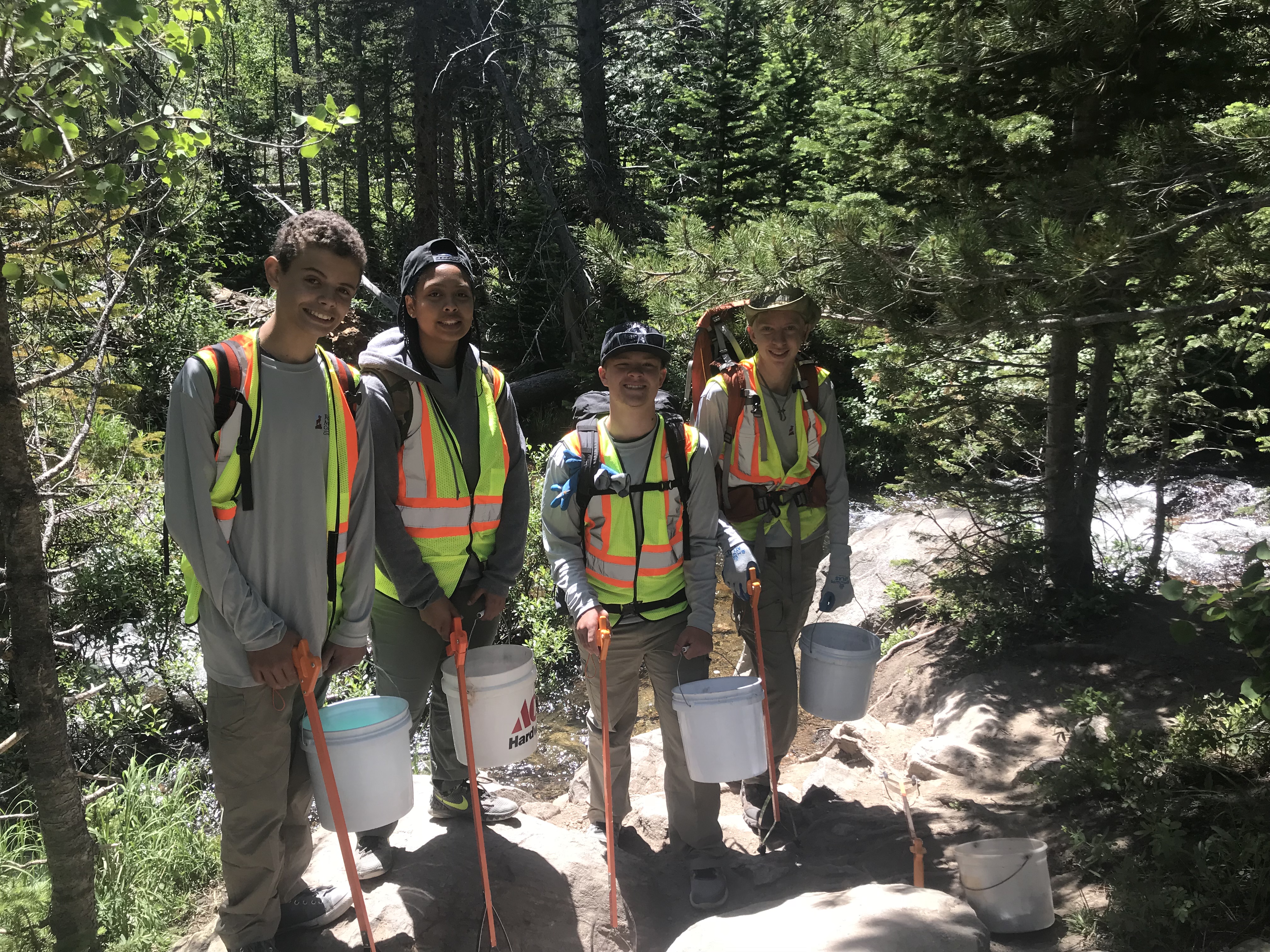
From Wednesday through Friday, the HSLC worked with Rocky’s Vegetation Crew (Veg Crew). The crew spent multiple days working to help eradicate a few different invasive species that plague the park. On Wednesday morning, the crew met with Grace and Kate at the volunteer office where they completed introductions and learned the task for the day: pulling Russian Thistle around the Moraine Park Discovery Center. This plant is what commonly becomes tumbleweed and can spread up to 250,000 seeds per plant, so the crew’s job was to do the best we could to completely remove it from the area. After a morning of vegetation, we met with Geoff Elliot, the Rocky Mountain Conservancy’s Director of Conservation, and he gave us a Behind the Scenes Tour of Rocky Mountain National Park Headquarters. This allowed the crew to explore a multitude of departments housed within the National Park Service that included the Wilderness office, Volunteer In Parks office, and Law Enforcement/Search and Rescue offices, the Park greenhouse, and the Fire Cache where the crew learned a little about fire mitigation and prevention.
On Thursday, the HSLC crew again met with the Veg Crew at Moraine Park Discovery Center, but this time the group traveled to the transit station and walked up the Bierstadt Lake trail. The HSLC used a grid system to locate and eliminate invasive species. Within this system, members all spread out an arm’s length apart and worked to walk as straight as possible. The goal that day was to pick Mullein. This is a long-stemmed plant with yellow flowers that when they mature can grow up to 6 feet high. This was a tiring project because of the uneven ground, but it was very rewarding when finished.
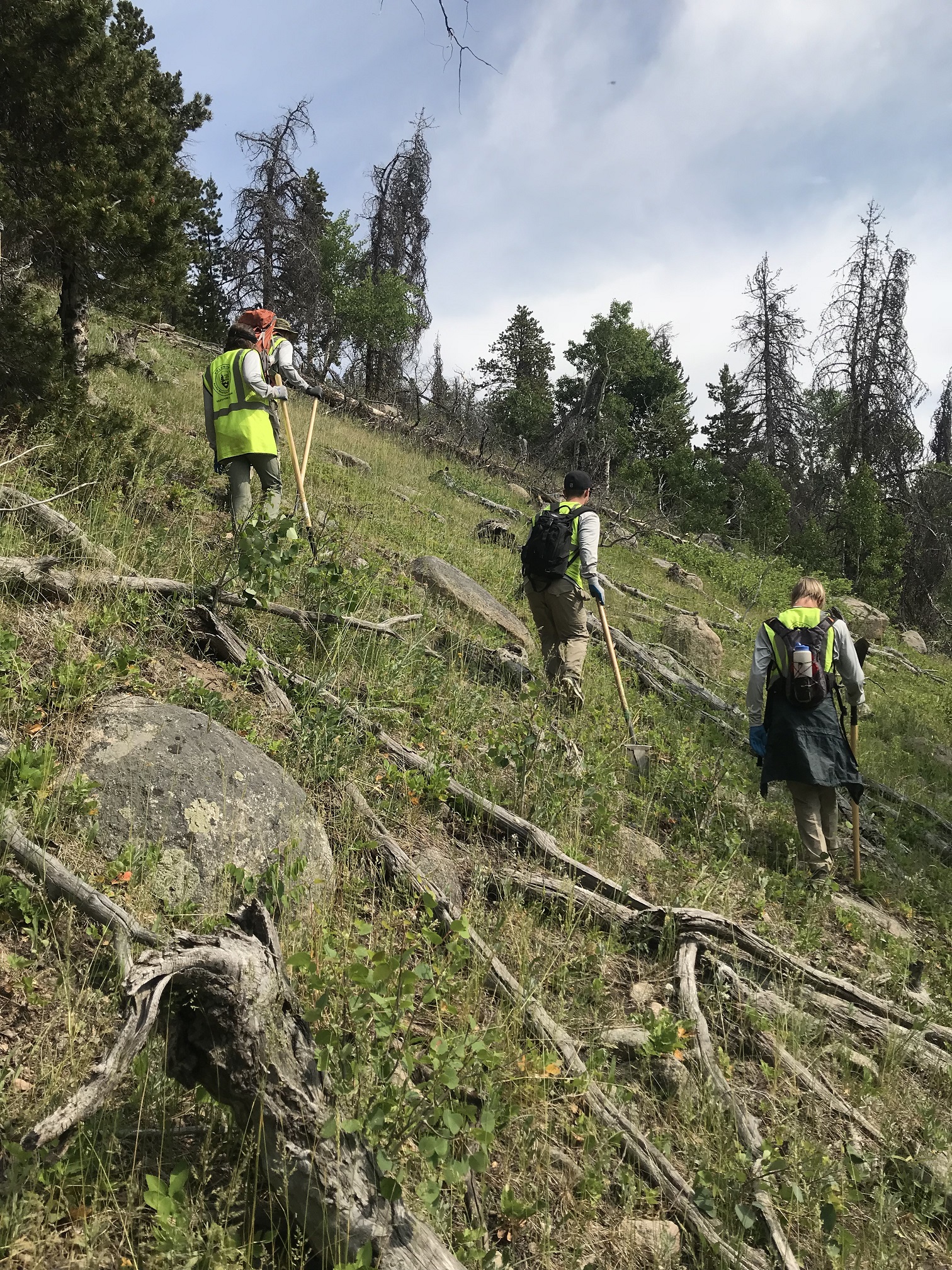

That afternoon Field Coordinator Morgan gave a lesson on plant identification around Rocky Mountain National Park where the members learned how to use a dichotomous key and specific ways in which one may differentiate different plant families. Everyone then travelled to the Field Institute and participated in a resume workshop. The crew worked together to learn how to build a strong resume, describe their experience here in the park, and how to tailor their resumes for specific jobs. We were also able to explore conservation job boards and federal hiring resources. That evening the HSLC attended Campfire Ghost Stories with the Rocky Mountain Conservancy – Field Institute, where the members learned what life was like for a trapper in the 1800s. The story was very engaging, and the trapper ended the evening by making us a fire with flint and brush for s’mores.
Friday, the HSLC spent their last day working with the Veg Crew. This time the crew was working on the South Moraine Park trail attacking Musk Thistle and Houndstongue. These two plants are two of the most troublesome in the park because they are transported around the park through animals. We spent all morning pulling a significant amount of these two plants over a quarter mile of trail.
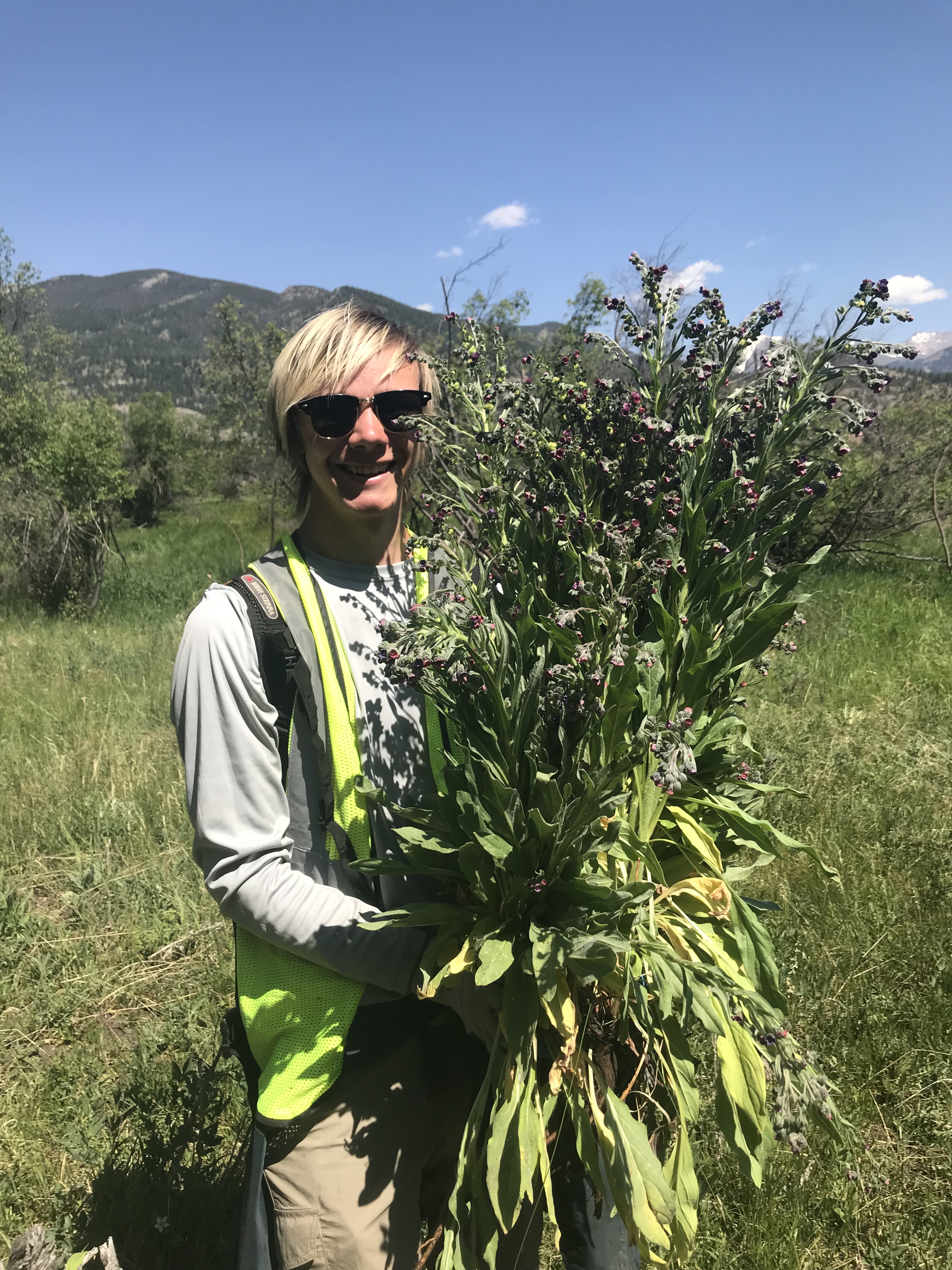

When the crew finished, they thanked Grace leading the week and went back to camp to prepare for a tour with Geoff of Trail Ridge Road that afternoon. The HSLC learned about the history of Trail Ridge Road and about the Tundra ecosystem it crosses. Geoff discussed how it can be heavily impacted by people if they are not attentive to what they are doing or where they are walking. Geoff emphasized the fragility of the system, and the kids learned first hand how harsh the Tundra winds can be. He had all the kids lay close to the ground and understand why plants can’t grow too high laterally to avoid the winds.
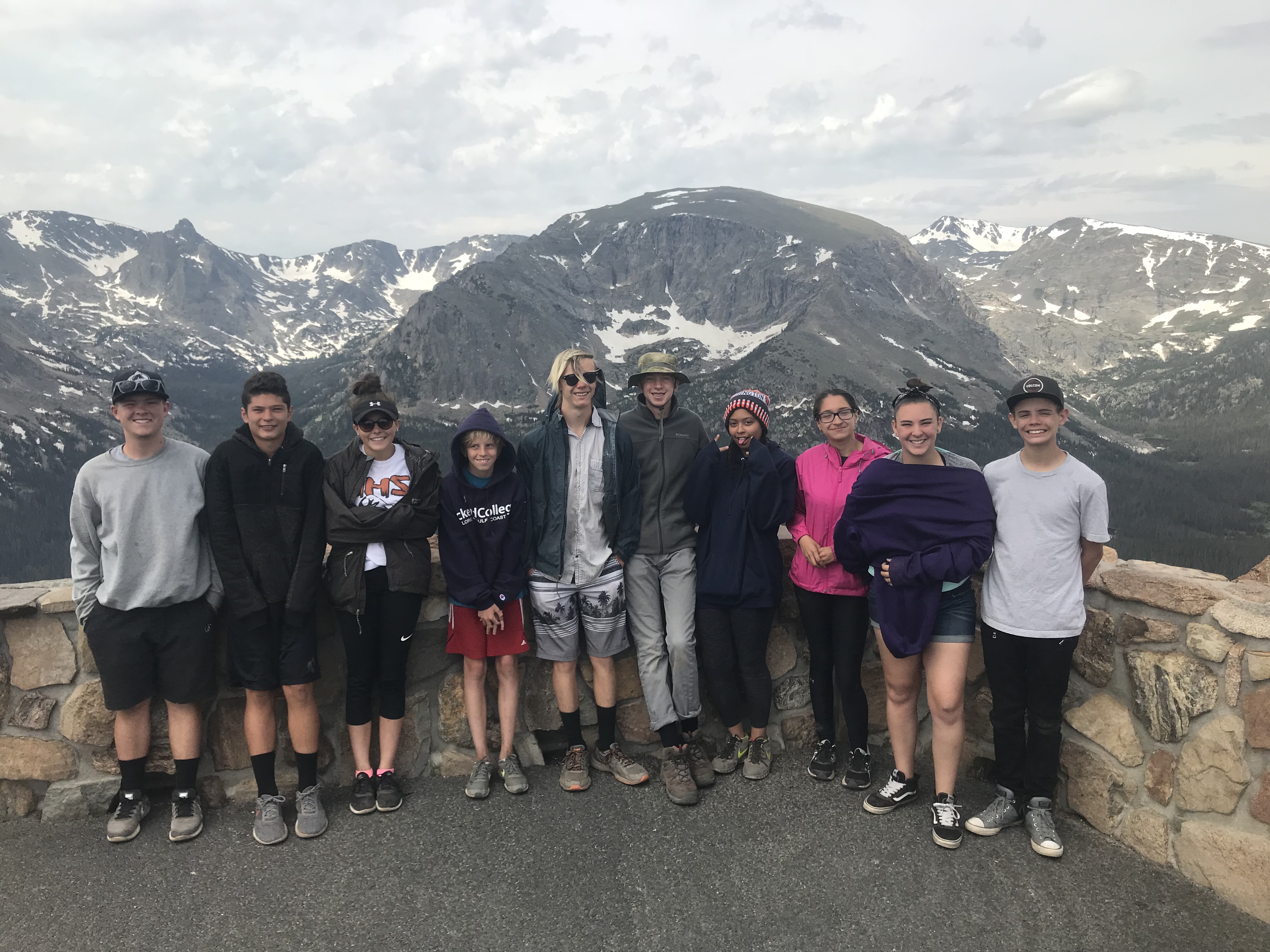

Over the weekend, to everybody’s enjoyment, they got to sleep in later than our usual 6:45am start. The HSLC went back over Trail Ridge to explore the other side of Rocky Mountain National Park and to see how the ecosystems change when you travel to the west side of the mountains. This side receives more moisture, and there was a significant shift in ecosystem types. The crew went for a short hike up the East Inlet trail to Adam’s Falls where they hung out for a while and learned a little about trail features they may see in the future. The group then drove down by Grand Lake and ate lunch and relaxed for a while. Once lunch was complete, they loaded up the cars and drove into the town of Grand Lake where everyone got to do some exploring at eat some ice cream from the legendary Dairy King. The HSLC then drove back to Estes Park and got settled for the evening and made dinner before playing a few good games of ninja and talking about what the next day and week were going to entail.
Sunday was a big day, this was the first time the members got to shower and do laundry since they had been in the program. Once everyone showered and relaxed, the HSLC headed back to the Field Institute and did a leadership test. This test was designed to use the members answers to personality questions to classify them into broad categories. This test is a good way to learn about how best to work with others, and how different personality types handle situations and problem solving. The HSCL also talked about the five stages of group development otherwise known as Forming, Storming, Norming, Performing, and Adjourning. Before starting the second week, Tommy and Morgan discussed the next week by outlining the basic project, building a bridge on the Lion Gulch Trail.
For the second week, the HSLC spent their time with the Poudre Wilderness Volunteers (PWV). The Lion Gulch Trail was heavily affected by the 2013 floods and both the PWV and the US Forest Service have been working hard to restore this trail to the public. The HSLC members were tasked with one of the final projects, a bridge to mitigate impact on the stream below. This was an amazing project that was both very rewarding and tiring. On the first day, the crew spent the morning digging sand and dirt to “armor” the trail, which means covering the rocks we gathered, cutting logs, and building rock ramps. The mighty crew also moved 23-foot logs to where the bridge was to be placed. This was very difficult and took nearly everyone on the project to carry. Once the logs were moved, the crew built the supports for the logs to sit on.
Slideshow:
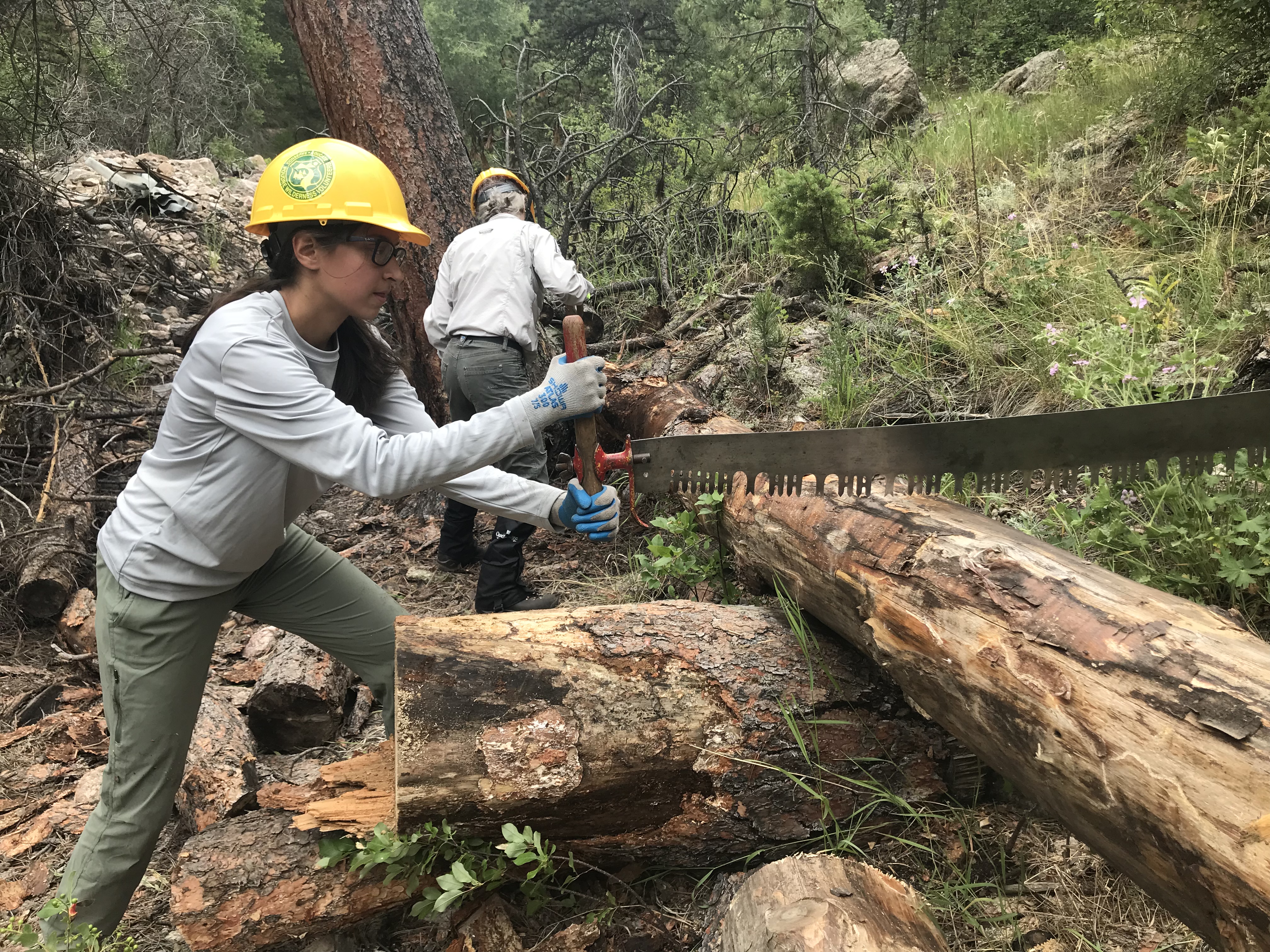

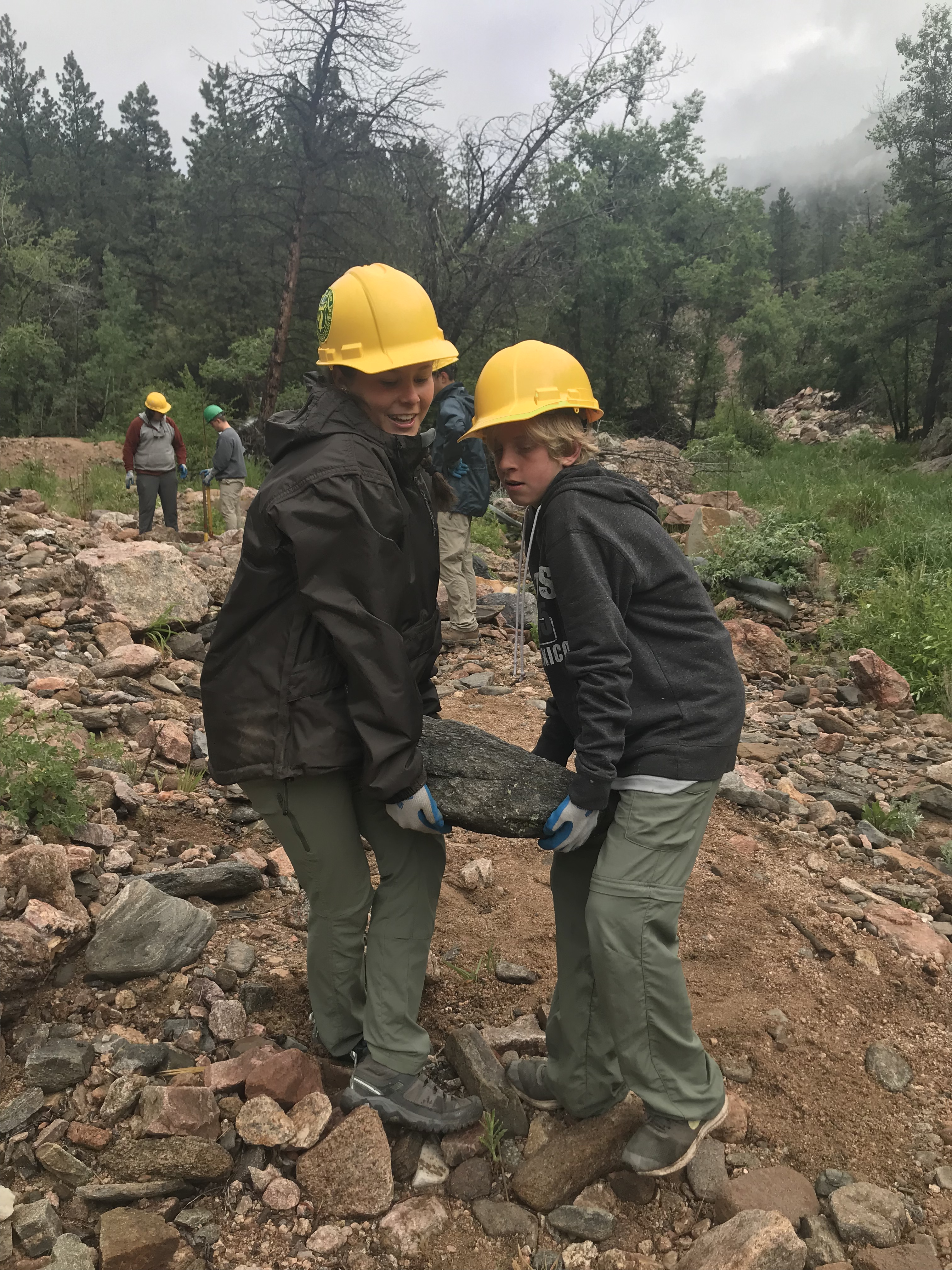

On Tuesday, the crew set the logs in place. This took some time, as the crew needed to get them properly placed and then cut notches, so the logs would sit flush. Once that was accomplished, the crew split into two groups. One group was helping to build large rock abutments to ensure the structure would be stable and strong and the other continued to notch the logs to convert the rounded surface into flat and easily walkable stretches of logs. The crew also spent significant time constructing ramps leading up to the bridge and carrying out debris that was washed down the stream from the flood.
Slideshow:


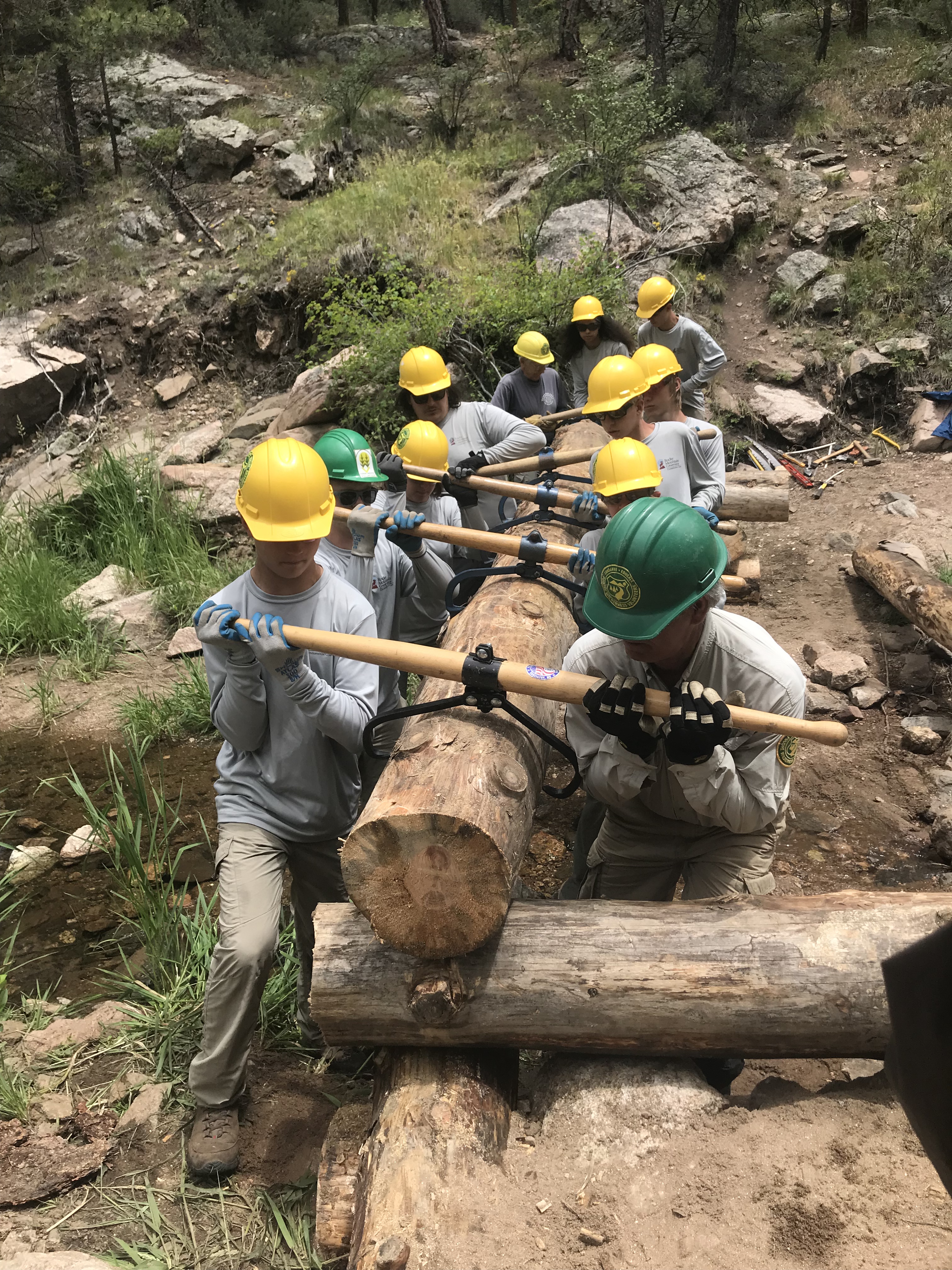

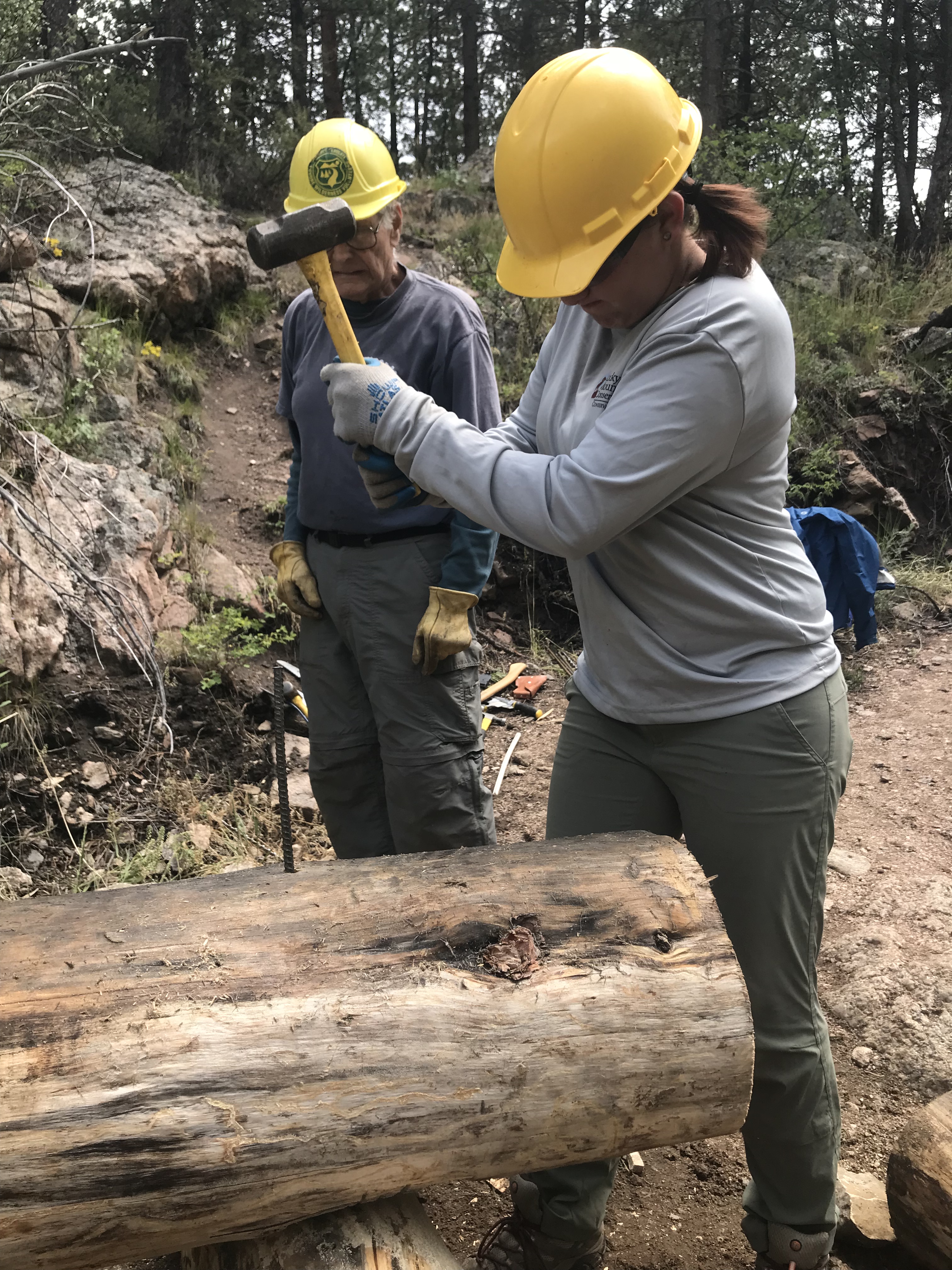

On Wednesday, the HSLC crew finished the bridge! They spent the day planking the logs and pounding in the rebar to ensure that the logs wouldn’t move when walked across. The crew also spent more time solidifying the abutments and finding the proper rocks to make the walk up to the bridge safe and easy on all those who hiked on the trail in the future. Finishing the bridge was a huge accomplishment that all who helped were excited about and happy to have gotten done.
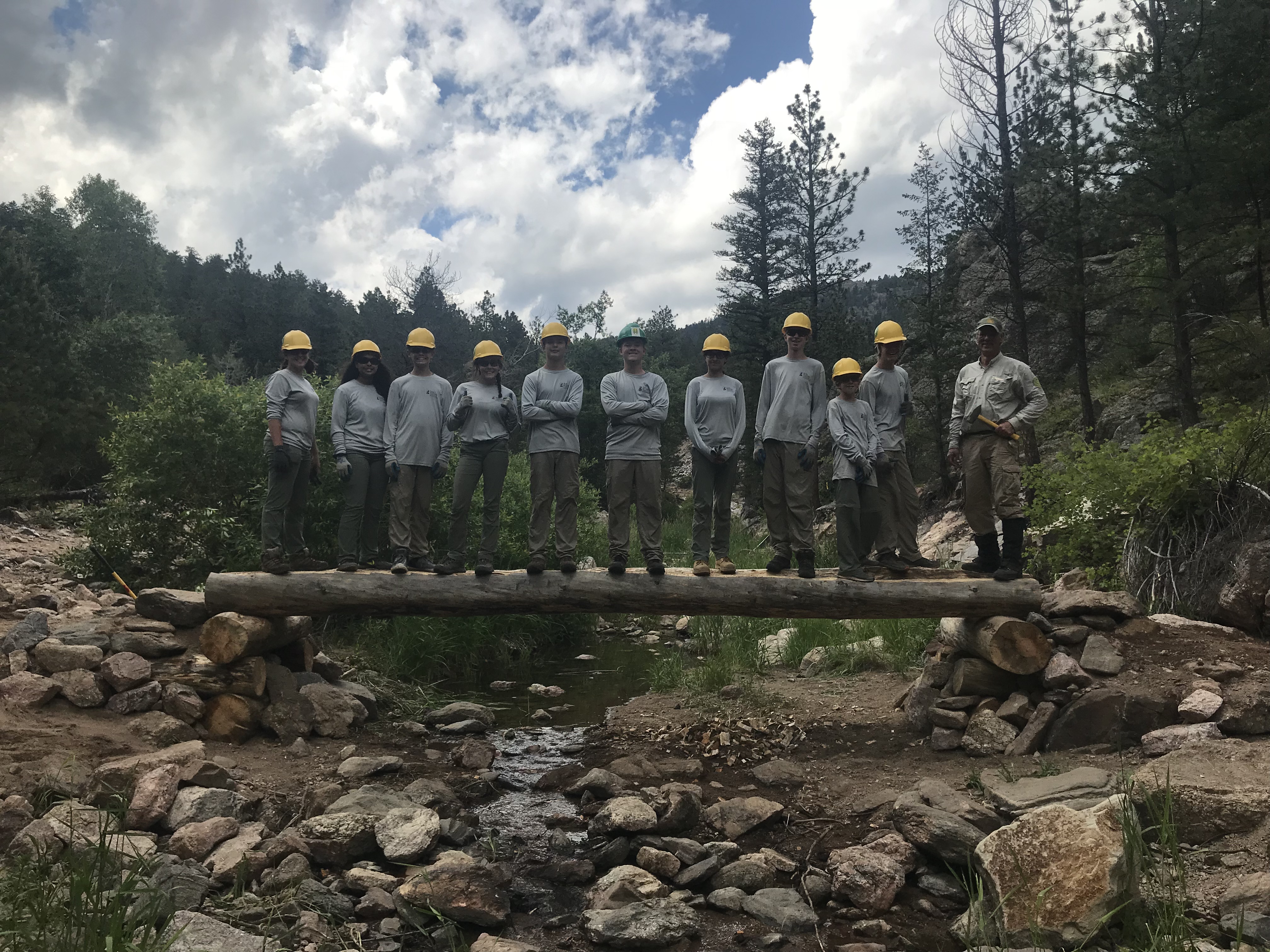

When Thursday came around the crew spent the day doing more traditional trail work. This entailed digging drains and building rock structures to divert water off the trail. They also worked to close part of the old trail that has since been rerouted. This was interesting because rather than moving trees or branches off the trail, the members were putting them on the trail to make it difficult to attempt to walk across, sending people down the new rerouted section of the trail. The crew then broke into groups one group went with the PWV lead and worked on clearing and making new drains while the other stayed behind to churn up the dirt so that some future volunteers could come through and drop grass seeds and transplant native flowers in hopes of restoring the old section of the trail. This day was great as it showed the participants what a typical day in trail work is like and that it isn’t all bridge building.
The end of the day was filled with a mix of emotions as people were excited to go back to their lives but were sad that they weren’t going to be around their new friends anymore. That night the crew celebrated after dinner with a campfire and s’mores for everyone. Members spent time reflecting on our experiences and all we had learned.
On the last morning the HSLC packed up around the campsite and brought everything back to the Field Institute. Tommy and Morgan conducted exit interviews with each member, while others helped with gear clean up. The HSLC program ended with a cook out for all the participants and their families. They were able to spend time with their families and introduce each other. It was great to hear everyone buzzing about their highlights and favorite projects.
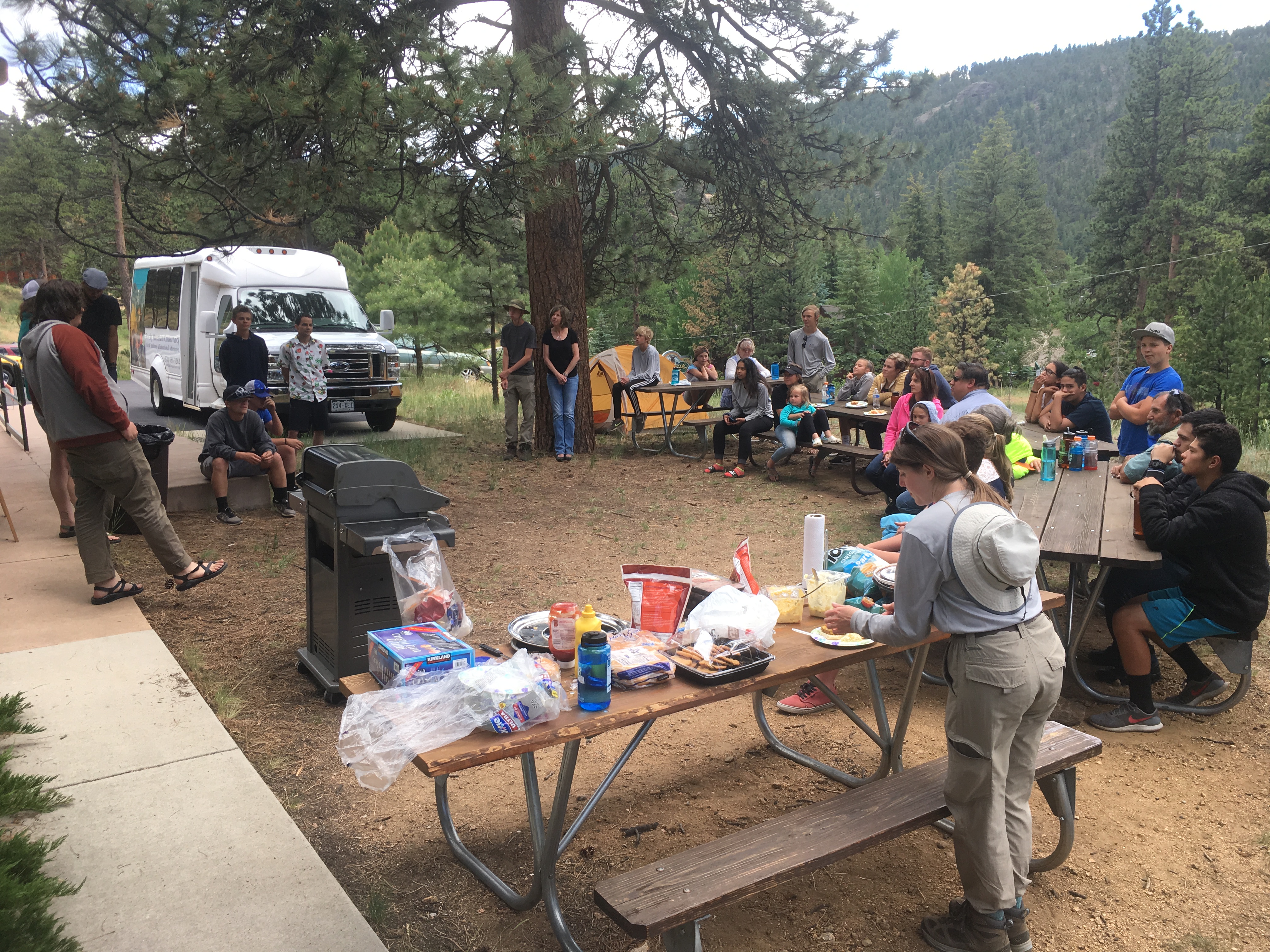

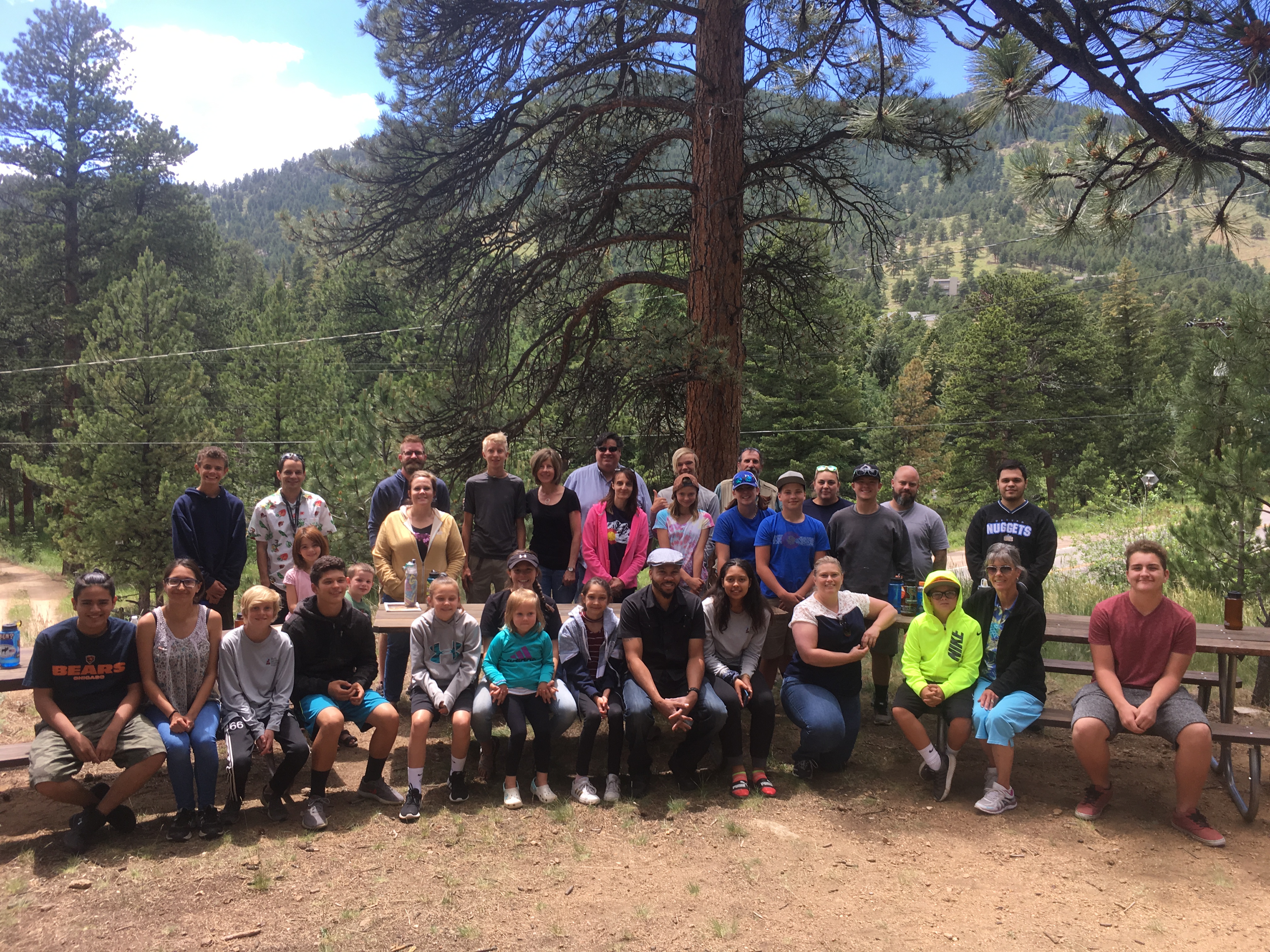

The Conservancy would like to thank all the family and friends who supported the crew members throughout their time with us.
Additionally, thank you to all of those who have purchased the Rocky Mountain National Park License Plate. If it wasn’t for your donation, this amazing opportunity wouldn’t exist!
Thank you to all that participated!
-Morgan Cannon & Tommy E (Field Coordinators/HSLC Leaders)
